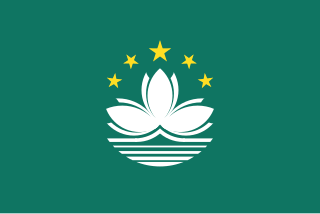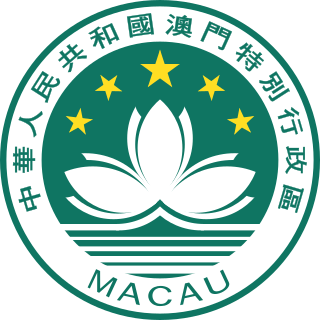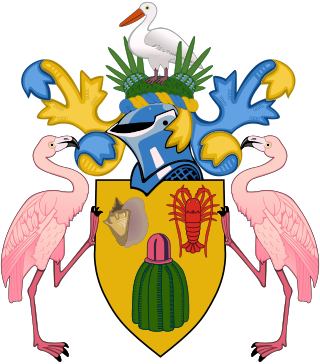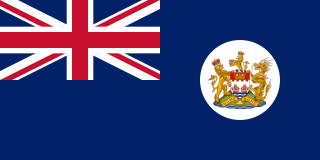
The coat of arms of South Africa is the main heraldic insignia of South Africa. The present coat of arms was introduced on Freedom Day, 27 April 2000, and was designed by Iaan Bekker. It replaced the earlier national arms, which had been in use since 1910. The motto is written in the extinct ǀXam, member of the Khoisan languages, and translates literally to "diverse people unite". The previous motto, in Latin, was Ex Unitate Vires, translated as "From unity, strength".

The Regional Flag of the Hong Kong Special Administrative Region of the People's Republic of China depicts a white stylised five-petal Hong Kong orchid tree flower in the centre of a Chinese red field. Its original design was unveiled on 4 April 1990 at the Third Session of the Seventh National People's Congress. The current design was approved on 10 August 1996 at the Fourth Plenum of the Preparatory Committee of the Hong Kong Special Administrative Region. The precise use of the flag is regulated by laws passed by the 58th executive meeting of the State Council held in Beijing. The design of the flag is enshrined in Hong Kong's Basic Law, the territory's constitutional document, and regulations regarding the use, prohibition of use, desecration, and manufacture of the flag are stated in the Regional Flag and Regional Emblem Ordinance. The flag of Hong Kong was officially adopted and hoisted on 1 July 1997, during the handover ceremony marking the handover from the United Kingdom back to China.

The Regional Flag of the Macau Special Administrative Region of the People's Republic of China is light green with a lotus flower above the stylised Governador Nobre de Carvalho Bridge and water in white, beneath a circular arc of five golden five-pointed stars: one large star in the center of the arc with two smaller stars on each side of the large star, each with a point angled directly outward from the center of the common circle on which they lie.

The flag of Barbados was designed by Grantley W. Prescod and was officially adopted to represent the nation of Barbados at midnight on 30 November 1966, the day the country gained independence. The flag was chosen as part of a nationwide open contest held by the government, with Prescod's design being selected as the winner of a field of over one thousand entries. The flag is a triband design, with the outermost stripes coloured ultramarine, to represent the sea and the sky, and the middle stripe coloured gold, to represent the sand. Within the middle band is displayed the head of a trident. This trident is meant to represent the trident of Poseidon, visible in Barbados's colonial coat of arms, and the fact that it is broken is meant to represent the breaking of colonial rule in Barbados and independence from the British Empire.

The current state flag of New South Wales was officially adopted in 1876. The flag is based on the defaced British Blue Ensign with the state badge located in the fly. The badge, based on the coat of arms, is a white disc with the cross of St George, a golden lion passant guardant in the centre of the cross and an eight-pointed gold star on each arm of the cross.

The current coat of arms of Zimbabwe was adopted on 21 September 1981, one year and five months after the national flag was adopted. Previously the coat of arms of Zimbabwe was identical to the former coat of arms of Rhodesia.

The Blue Sky with a White Sun is the national emblem of the Republic of China (Taiwan).

The coat of arms of Queensland is one of the formal symbols of the Australian state of Queensland and represents the King's constitutional authority throughout the state. It is the oldest of the state arms of Australia, having been granted in 1893 by Queen Victoria, through the simplest heraldic grants of only the shield of arms, motto, helmet, mantling and crest. In 1977, the red deer and the brolga were assigned as supporters by Queen Elizabeth II during her Silver Jubilee.

The flag of Cape Colony was the official flag of the Cape Colony from 1876 to 1910. It formed part of a system of colonial flags that was used throughout the British Empire.

The national emblem of Indonesia is called Garuda Pancasila. The main part is the Garuda with a heraldic shield on its chest and a scroll gripped by its legs. The shield's five emblems represent Pancasila, the five principles of Indonesia's national ideology. The Garuda claws gripping a white ribbon scroll inscribed with the national motto Bhinneka Tunggal Ika written in black text, which can be loosely translated as "Unity in Diversity". Garuda Pancasila was designed by Sultan Hamid II from Pontianak, supervised by Sukarno, and was adopted as the national emblem on 11 February 1950.
This is a list of coats of arms of the United Kingdom, its constituent parts, Crown Dependencies and its Overseas Territories.

The HSBC Building is a six-floor neo-classical building in the Bund area of Shanghai, China. It served as the headquarters of the Shanghai branch of The Hongkong and Shanghai Banking Corporation from 1923 to 1955, and currently houses the Shanghai Pudong Development Bank. The building is situated at number 12, the Bund. Designed by the British architecture firm Palmer & Turner Architects and Surveyors, construction of the building lasted from 5 May 1921 to 23 June 1923.

The coat of arms of New South Wales is the official coat of arms of the Australian state of New South Wales. It was granted by royal warrant of King Edward VII dated 11 October 1906.

The Regional Emblem of the Macao Special Administrative Region of the People's Republic of China came into use on 20 December 1999, when the sovereignty of Macau was handed over from the Portuguese Republic to the People's Republic of China. The emblem is now referred to officially as the "Regional Emblem" (區徽).

The coat of arms of the Turks and Caicos Islands consists of a gold-coloured escutcheon (shield) charged with a conch shell, lobster and a cactus, supported by two flamingos, and topped with a pelican in the crest. Adopted three years after the islands became a Crown colony, it has been the coat of arms of the Turks and Caicos Islands since 1965. The escutcheon is featured on the flag of the territory. The previous badge featured two mounds of salt in front of a ship, with doors added to the mounds after they were reportedly mistaken for igloos.

The official coat of arms of Grenada is a shield divided into four parts by a golden cross. In the centre of this cross is the Santa Maria, Columbus' flagship. A lion passant guardant on a red field is shown in the upper left and lower right sections of the shield, with a golden crescent moon out of which a lily grows in the upper right and lower left sections. Above the shield there is a golden helmet, topped with a garland of bougainvillea branches. Within the garland are seven red roses, which stand for the seven communities of Grenada. Holding the shield on the dexter side is a nine-banded armadillo which stands before a corn stalk; on the sinister side is a Grenada dove, which stands before a banana plant. The base represents Mount St. Catherine with the Grand Etang Lake at the centre. A ribbon displays the national motto: "Ever conscious of God we aspire, build and advance as one people."

The flag of the governor-general of New Zealand is an official flag of New Zealand and is flown continuously on buildings and other locations when a governor-general is present. The flag in its present form was adopted in 2008 and is a blue field with the shield of the New Zealand coat of arms royally crowned. The official heraldic description is "A flag of a blue field thereon the Arms of New Zealand ensigned by the Royal Crown all proper".

The Star of India refers to a group of flags used during the period of the British Raj in the Indian subcontinent. India had a range of flags for different purposes during its existence. The Princely states had their own flags which were to be flown alongside the British flag as a symbol of suzerainty. The official state flag for use on land was the Union Flag of the United Kingdom and it was this flag that was lowered on Independence Day in 1947. The flag of the governor-general of India was defaced with the Star of India. The civil ensign and naval ensign were the Red Ensign or Blue Ensign, respectively, defaced with the Star of India emblem.

The coat of arms of Singapore is the heraldic symbol representing the sovereign island country and city-state of Singapore located in maritime Southeast Asia. It was adopted in 1959, the year Singapore attained self-governance from the British Empire, and remains in use after its independence in 1965. The committee that created it, headed by Toh Chin Chye, who was also responsible for the national flag and the national anthem of Singapore.

The flag of Hong Kong from 1871 to 1997 was a Blue Ensign with the coat of arms of Hong Kong on a white disk. In Hong Kong, it is also nicknamed the Hong Kong flag (香港旗), British Hong Kong flag (英屬香港旗) or the Dragon and Lion flag (龍獅旗). In 1959, following a grant from the College of Arms and with the consent of Queen Elizabeth II, it was adopted as the flag of British Hong Kong. While the flag lost its official status following the 1 July 1997 transfer of sovereignty over Hong Kong, it resurfaced in the 2010s as a symbol of support for Hong Kong autonomy and protest against Chinese interference in Hong Kong.

























